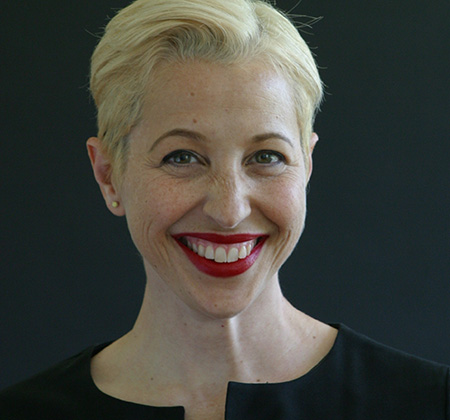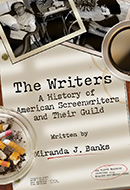Banks’ book has exclusive Guild material

Assistant Professor Miranda Banks of Visual and Media Arts is releasing a new book that includes exclusive archival material from the Writers Guild Foundation, along with 50 interviews with legendary Hollywood screenwriters, including Norman Lear ’44, Carl Reiner, and Mel Brooks. (Courtesy Photo)
A new book by Assistant Professor Miranda Banks that includes never-before-seen material from the archives of the Writers Guild Foundation—along with 50 interviews from legendary screenwriters—is a must-read for any student, academic, or professional learning about the industry, its screenwriters, and their guilds.
“Many of our students will go on to work in the industry,” Banks said. “I believe part of my role as a professor is to help students understand the art, the history, and the cultures of media production they will be entering.”
 The History of American Screenwriters and Their Guild (Rutgers University Press) is being released January 14. Research was partially funded by the Emerson College Faculty Advancement Fund Grant.
The History of American Screenwriters and Their Guild (Rutgers University Press) is being released January 14. Research was partially funded by the Emerson College Faculty Advancement Fund Grant.
Banks, who teaches in the Visual and Media Arts Department and is a fellow at the Engagement Lab, was granted unprecedented access to the archives of the Writers Guild Foundation to gain material for the book, which included 100 never-before-published oral histories with legends such as Nora Ephron and Ring Lardner Jr.
Banks also interviewed more than 50 screenwriters, including Mel Brooks; Carl Reiner; and Emerson alumnus Norman Lear ’44, the legendary writer and producer of All in the Family, The Jeffersons, One Day at a Time, and many other sitcoms.
“Every single writer I approached agreed to be interviewed for this book,” Banks said. “People were incredibly generous with their time. I think that speaks to their interest in the roles of writers and writing.
“I might just be the luckiest person in the world,” she said, “since my research entailed talking to Norman Lear for four hours.”
In the classroom, Banks teaches her students about the relevancy of media history to today’s industry.
“I hope that I have added to the tools they will need in their future classes and in their future careers,” she said. “My goal is to help them become more enlightened and responsible users and makers of media.”
What is the most fascinating thing you uncovered?
“In doing this work, I have found myself falling in love with the words of writers and the extraordinary stories of their lives—stories that are often more wild and woolly than the scripts they wrote. There are terrible stories of anger and loss during the blacklist in the 1940s and ’50s and there were awful accounts of how difficult it was for female writers to work in the industry during the 1970s and 1980s. But there’s also endless laughter—writers laughing at the absurdities of the industry, at the ups and downs of the profession, and, most often, laughing at themselves.
“What treats did I find in the archive? I think my favorite was the seating chart for a Screen Writers Guild dinner dance in 1937. Now that was a party. At Charles Brackett’s table: Irving Berlin, Billy Wilder, Moss Hart, and Ernst Lubitsch. At Albert Hackett’s table: Joan Blondell, Dick Powell, and Jimmy Cagney. At Dorothy Parker’s table: Dashiell Hammett, Lillian Hellman, Frederick March, and King Vidor. At another table: Groucho Marx and friends, and Ogden Nash. Where would you sit?”
What is the current political climate surrounding screenwriter guilds and unions, and will those organizations continue to hold power?
“Anyone interested in working in the media industries needs to stay on top of the news and the trades, but also to be culturally aware. Think of an issue like the recent Sony hack. At first, the hack was about racial stereotyping in films, breaches of privacy, and uncovering gossipy emails and nasty comments by higher-ups. But there is so much more behind this story to be debated and discussed. The industry is changing quickly and students need to not only understand issues like global media and racial stereotyping, digital distribution and net neutrality, minority hiring and sexism in the industry, piracy and privacy, and national and global politics’ role behind the scenes and behind our screens—but they also need to be able to articulate their opinions and have ideas for positive change.”
How did you decide to explore the archives of the Writers Guild Foundation?
“I knew that if I wanted to write a history of writers I wanted to talk to individual writers, [and] to understand them as a community—and that meant going to the Guild. After a good deal of research more locally in Boston, I went out to Los Angeles to start researching at the Writers Guild Foundation Library. In 2009, I met with Head Librarian Karen Pederson and told her my vision for the book. She looked me in the eye and said, ‘Thank goodness someone is going to do this.’ For four years, every time I went to Los Angeles, I would split my time between conducting interviews and sifting through a storage room full of boxes uncovering the treasures of the library’s holdings. A year after I started this project, the Writers Guild Foundation Library hired its first archivist, Joanne Lammers. Over the last few years, Joanne and I have become partners in exploring this history and trying to piece together this extraordinary history.”
Categories